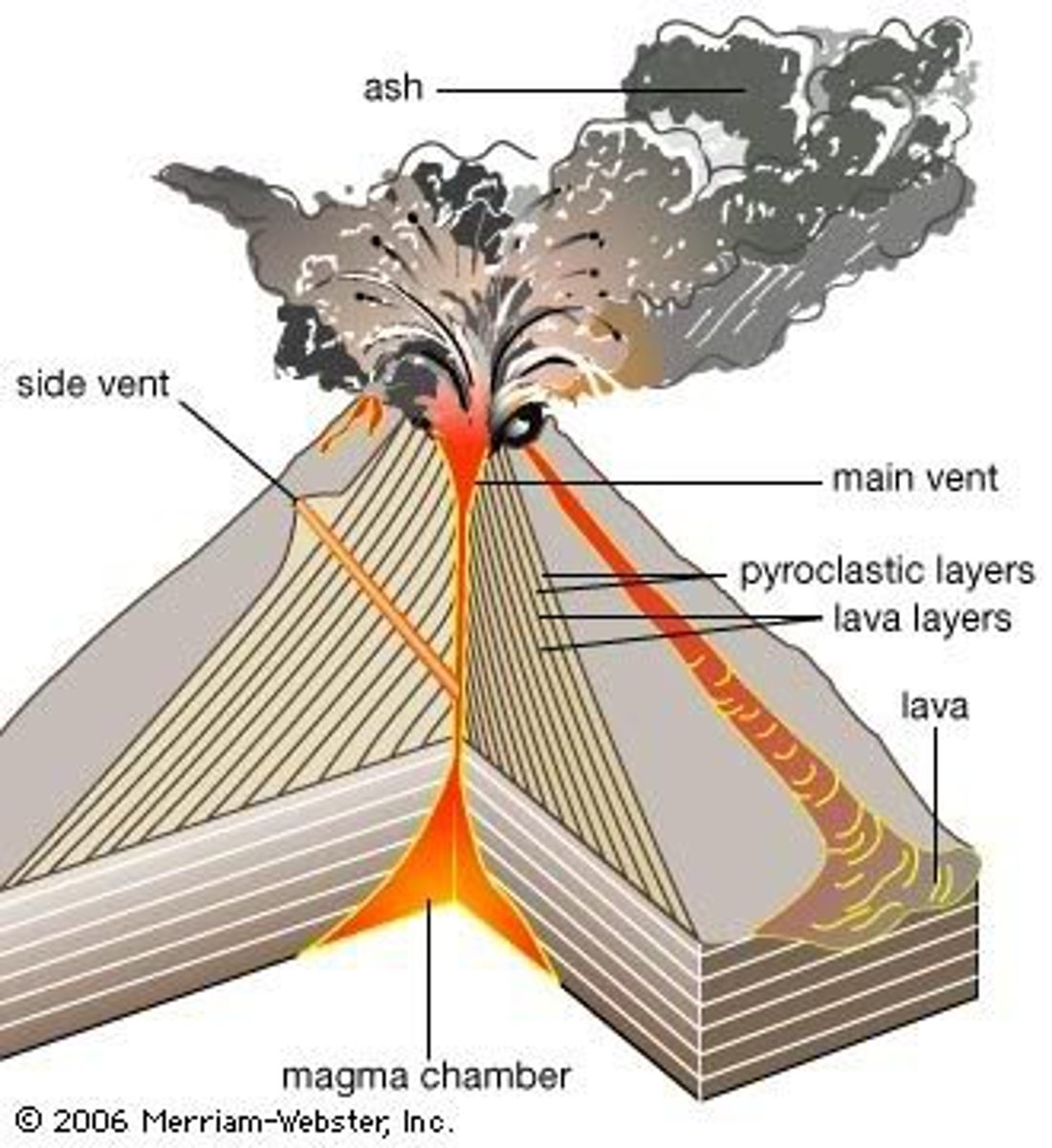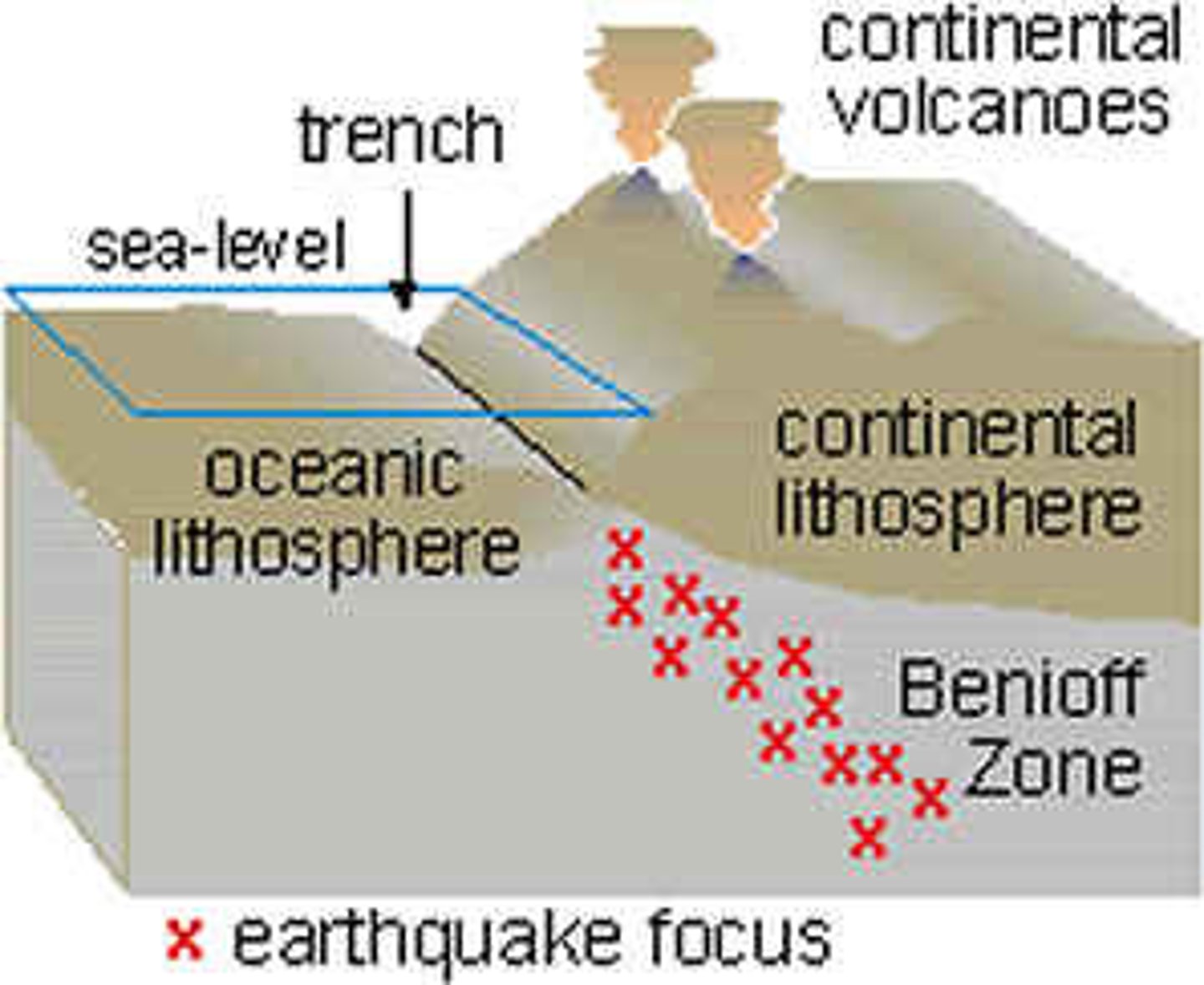Hazardous Earth key idea 2.
1/30
Earn XP
Description and Tags
hazards generated by volcanic activity
Name | Mastery | Learn | Test | Matching | Spaced |
|---|
No study sessions yet.
31 Terms
How does volcanic activity affect landforms and landscapes?
Explosive eruptions form:
Strato (composite) volcanoes made up of layers of tephra and acidic lava which contain complex internal systems which create dykes and sills underground.
Caldera craters which appear as a large crater, group of small islands or as a large lake.
Describe and explain the formation of strato volcanoes (composite volcanoes)
Description: cone-like, steep-sided, have a crater at the top, composite (made up of layers), have secondary vents
layers of ash + acid lava built up over eruptions.
lava intrudes into layers, forming sills and dykes
vents of volcano can be sealed by solidified magma/lava
pressure builds up, results in explosive eruptions.
magma erupts violently as air bubbles finally burst.
throws droplets of lava as tephra and lava bombs.
E.g. Mount Etna, Italy

explain the formation of calderas
explosive eruptions empty the magma chamber beneath the volcano.
the lack of support beneath causes the volcano to collapse on itself, forming a caldera crater.
collapsing of volcano's sides can cause tsunamis.
E.g. Krakatoa, India
Describe the causes of earthquake activity found at convergent plate boundaries
two plates being pushed into one another which builds up immense amount of pressure.
faulting and fracturing takes place in the benioff zone.
causes pressure and energy to be released which creates earthquakes.
What is the benioff zone?
The boundary between the subjecting ocean plate and over-riding continental plate.
Seismic energy is released here as rocks fault and fracture.

What is a hot spot?
A particularly hot section of mantle. This can melt through the crust causing volcanic activity.
Hot spots usually occur away from plate boundaries.
Some are found at plate boundaries, e.g.Iceland
Describe the formation of volcanic Islands at a hot spot (Hawaii)Plume of particularly hot mantle.
Plume of particularly hot mantle.
Melts through crust forming volcano and island.
Movement of plate transports volcano away from hot spot.
Volcano becomes extinct. New volcano formed at hot spot.
Islands have been eroded by waves, weathering and mass movement making the older islands much smaller.
Describe the earthquake activity experienced at a hot spot
They are caused by a build-up of pressure and movement of ground due to volcanic activity.
Small earthquakes
Frequent
Caused by movement of magma
What is a super volcano
A volcano that erupts more than 1000km^3 of material in a single eruption.
Are usually found as giant calderas.
They occur when rising magma cannot break through crust.
Pressure increases as more magma rises until magma violently forces its way through as a huge eruption.
Outline different Lava flows based on silica content
Basic (Basaltic)
Lava is free-flowing and can run for considerable distances.
Acidic, viscous lava
Everything in the path of lava is burned/buried destroying infrastructure/properties/crops.
Rarely cases injuries/fatalities because people can escape the flow.
what are pyroclastic flows?
Combination of hot gases (500degC+), ash and rock fragments travelling at high speeds (100km/hr).
Follow contours of ground and destroy everything in path.
Inhalation of hot, poisonous gas can result in almost instant death.
what is tephra?
Any material ejected from volcano into air.
Fine ash/volcanic bombs.
Buries farmland, destroying crops, disrupts transport on ground and in air.
Iceland's volcanic eruption (2010) led to cancellation of 100,000 flights.
Builds can collapse due to weight of accumulated ash.
People with respiratory diseases have difficulty breathing.
Gas emissions (CO, CO2, SO2)
Deadly threat to humans.
SO2 combines with atmospheric water, produced acid rain.
Enhances weathering can damage crops and pollute surface water and soils.
what are lahars?
Type of mud flow (consistency of wet concrete).
Travel up to 50km/hr.
Destroy/bury everything in it's path.
Eruption in Columbia (1984) killed 23,000 due to lahars.
how do floods form from volcanic activity?
Volcanic eruptions beneath ice field/glacier results in rapid melting.
Iceland's volcano lies beneath ice and snow.
Eruptions cause vast quantities of water to accumulate until it finds an exit.
Results in torrents of water, can cause devastating floods.
how do tsunamis form from volcanic activity?
Eruptions of island volcanoes cause displacement of ocean water creating tsunami waves that travel up to 600km/hr.
Tsunamis created by eruption of Krakatoa in 1883 believed to have drowned 36,000 people.
What are earthquakes?
The release of stress that has built up within the Earth's crust caused by tension, compression or the shearing of rocks.
Release of energy causes seismic waves to be released from the focus.
Parts of an earthquake?
Focus point at which waves originate from (point where stress is released).
Epicentre directly above the focus (where most severe impacts will be).
Seismic waves energy released travels as waves.
Fault line where movement in plates occur.
Where do earthquakes happen?
Mid-ocean ridge (divergent boundary)/rift valleys (constructive boundary)
Ocean trenches (convergent boundary)/island areas (destructive)
Collision zones (convergent)
Conservative margins (conservative)
Away from plate margins
Shallow focus earthquakes
0-70km deep
Occur in cold, brittle rock resulting from fracturing of rocks due to stress within the crust
Very common
Releasing low levels of energy
High-energy, shallow quakes are capable of causing severe damage
Deep focus earthquakes
70-700km deep
Increasing depth = extreme temps/pressures
Why is the Mw a more useful scale than the others?
Measures direct energy that causes ground movement so can be used to predict damage.
Effects of earthquakes on landforms and landscapes
Associated with formation of mountain ranges (e.g. Himilayas) at collision boundaries.
Collision of India and Eurasian plates led to complex pattern of folding and faulting of rocks creating the world's highest fold mountains: 96/109 of world's peaks >7000m located here.
Rift valleys along mid-ocean ridges (e.g. East Africa - evidence of earthquakes on morphology of Earth's surface)
Fault scarps and escarpments of rift valleys mark locations of faults caused by tension and compression within crust.
Rift valleys are weathered and eroded so over time fault scarps are worn away and blend into landscape, can even disappear under accumulated sediments.
what is liquefaction?
Vibrations of quake cause surface materials with high water contents (fine-grained sands, alluvium, landfill) to behave like liquids.
Materials loose strength; slopes (river banks) collapse and structures tilt and sink as foundations give way.
Classifying volcanoes
Active: erupted within the last 10,000 years.
E.g. Kilauea (Hawaii) erupting continuously since 1983.
Dormant: has not erupted in last 10,000 years, expected to erupt some time in future.
E.g. Yellowstone erupted 70,000 years ago. There are ongoing earthquakes, geothermal features such as geysers and ground inflation).
Extinct: not expected to erupt ever again.
E.g. Kohala (Hawaii) erupted 120,000 years ago.
Japan: Context
Location:
- Tohoku, Honshu Island, Japan, East Asia
- 70km offshore
- North part of main island
Tectonic context:
- Convergent (destructive) oceanic-continental plate boundary
- Pacific (oceanic) subducts beneath Eurasian (continental)
- 9.0Mw (BIG)
- Shallow focus earthquake (30km deep)
- 11th March, 2011
- Numerous aftershocks (7.0-8.0Mw)
Japan: reasons why people choose to live here
Perception of risk
- Investment in education/engineering builds feeling of security.
- Experiences 400 earthquakes each day (most can't be felt) - minor earthquakes help Japanese feel accustomed to these hazards.
Earthquakes and their effects are part of Japanese culture and folklore.
Small geo-thermal power plants since the 1960's.
- There has been an attempt to increase the scale of operations especially in the wake of the Fukushima nuclear meltdown.
Intensive agricultural industry made possible by extremely fertile volcanic soils.
Volcanic activity has become a major tourist attraction in Japan.
Japan
Impacts experienced (2011)
Largest ever earthquake to hit Japan (9.0Mw).
Shaking lasted 3-7 minutes.
Many aftershocks.
7.0-8.0Mw
Tsunami waves created.
Reaching up to 40.5m tall (far higher than sea defences).
Travelled 10km inland (reaching the city of Sendai).
Waves reached Antarctica and USA.
Earthquake nocked out power supply to Fukushima Nuclear Power Plant.
Tsunami flooded back-up generators and triggered nuclear meltdown in three reactors.
400km stretch of coastline dropped 0.6m vertically.
Honshu island moves 2.4m east.
Japan
ECONOMIC impacts on country
Cost of the event estimated at nearly $181 billion.
45,700 buildings destroyed; 143,300 damaged.
15 ports damaged, 4 destroyed.
4.4. mullion households and thousands of businesses in northeast Japan were left without electricity.
Japanese stock market fell - major companies affected (Sony, Toyota, Panasonic) as power cuts halted production and port damage prevented export of goods.
Fishing industry affected as radioactive wast contaminates Pacific Ocean.
Farmland flooded by tsunami contained by salt - land made infertile.
Fukushima nuclear power plant had to be decommissioned after meltdown.
Japan
SOCIAL impacts on country
16,000 people were killed and 6,000 injured.
Bodies disposed of in mass graves to reduce the chance of disease.
Children separated from families (Save the Children reported 100,000 children affected).
2000 young people were either orphaned or lost 1 parent.
Extent of damage meant reconstruction of house, schools and health centres took 5 years.
5,800 people evacuated and permanently relocated from their family home after being evacuated from 30km fallout zone following Fukushima event.
Internal migration of people from Tokyo to Osaka in the months following the Fukushima event.
Japan
POLITICAL impacts on country
Government increased national debt to help recovery efforts; spent billions of yen to stabilise economy.
A large movement against nuclear power has developed and spread globally.
The government is yet to decide on the future of nuclear power.
International travel advice against visiting Japan (USA, France, Australia).
Foreign residents (e.g. international students) left the country.